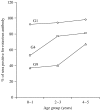Genotypic characterization of rotaviruses and prevalence of serotype-specific serum antibodies in children in Kuwait
- PMID: 17291379
- PMCID: PMC2870697
- DOI: 10.1017/S0950268807007868
Genotypic characterization of rotaviruses and prevalence of serotype-specific serum antibodies in children in Kuwait
Abstract
There are no data on the serotypes of rotaviruses prevalent in Kuwait, which has a large expatriate population and hence a focal point for transmission of pathogens. The serotype information will contribute to the fund of knowledge on the world epidemiology of rotavirus serotypes and will predict the outcome of vaccination in Kuwait. Of the 75 rotavirus-positive samples from 172 children (aged <5 years) with severe diarrhoea, 69 were genotyped. The distribution of genotypes was G1 (63.8%) followed by G9 (10.2%), G2 (7.3%), G4 (7.3%) and G3 (4.4%). Among the P types, P[8] was the most common type found across all G types. By fluorescent focus neutralization test, serum antibodies to genotypes G1 (94%), G4 (68%) and G9 (46%) were found in 120 other children. These results show that G1 is the predominant serotype in Kuwait and that a vaccine that contains G1 will be most effective.
Figures
Similar articles
-
Molecular epidemiologic analysis of group A rotaviruses in adults and children with diarrhea in Wuhan city, China, 2000-2006.Arch Virol. 2007;152(4):669-85. doi: 10.1007/s00705-006-0904-y. Epub 2007 Jan 3. Arch Virol. 2007. PMID: 17195953
-
Diversity of human rotavirus G9 among children in Turkey.J Med Virol. 2008 Apr;80(4):733-40. doi: 10.1002/jmv.21120. J Med Virol. 2008. PMID: 18297696
-
Dominating prevalence of P[8],G1 and P[8],G9 rotavirus strains among children admitted to hospital between 2000 and 2003 in Budapest, Hungary.J Med Virol. 2005 Jul;76(3):414-23. doi: 10.1002/jmv.20372. J Med Virol. 2005. PMID: 15902709
-
Rotavirus infections in children in Turkey: A systematic review.Rev Med Virol. 2019 Jan;29(1):e2020. doi: 10.1002/rmv.2020. Epub 2018 Dec 4. Rev Med Virol. 2019. PMID: 30511804
-
Epidemiology of rotavirus infection in Thailand.Pediatr Int. 2000 Aug;42(4):415-21. doi: 10.1046/j.1442-200x.2000.01251.x. Pediatr Int. 2000. PMID: 10986880 Review.
Cited by
-
Circulating rotavirus G and P strains post rotavirus vaccination in Eastern Mediterranean Region.Saudi Med J. 2018 Aug;39(8):755-766. doi: 10.15537/smj.2018.8.21394. Saudi Med J. 2018. PMID: 30106412 Free PMC article. Review.
-
Rotavirus Genotypes and Vaccine Effectiveness from a Sentinel, Hospital-Based, Surveillance Study for Three Consecutive Rotavirus Seasons in Lebanon.PLoS One. 2016 Aug 29;11(8):e0161345. doi: 10.1371/journal.pone.0161345. eCollection 2016. PLoS One. 2016. PMID: 27571515 Free PMC article.
-
The molecular epidemiology of circulating rotaviruses: three-year surveillance in the region of Monastir, Tunisia.BMC Infect Dis. 2011 Oct 3;11:266. doi: 10.1186/1471-2334-11-266. BMC Infect Dis. 2011. PMID: 21967503 Free PMC article.
-
Systematic review of the rotavirus infection burden in the WHO-EMRO region.Hum Vaccin Immunother. 2019;15(11):2754-2768. doi: 10.1080/21645515.2019.1603984. Epub 2019 May 17. Hum Vaccin Immunother. 2019. PMID: 30964372 Free PMC article.
-
Burden of rotavirus gastroenteritis in the Middle Eastern and North African pediatric population.BMC Infect Dis. 2011 Jan 7;11:9. doi: 10.1186/1471-2334-11-9. BMC Infect Dis. 2011. PMID: 21214934 Free PMC article. Review.
References
Publication types
MeSH terms
Substances
LinkOut - more resources
Full Text Sources
Medical



